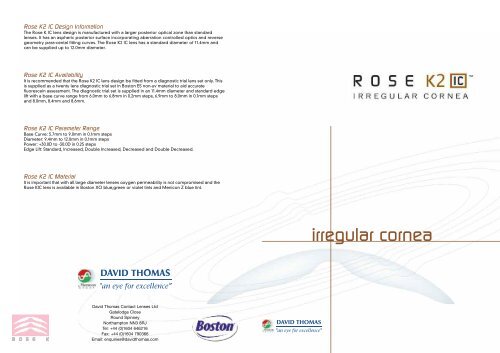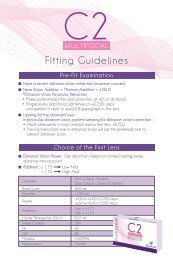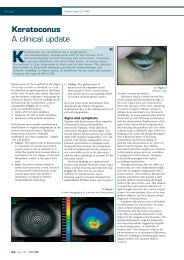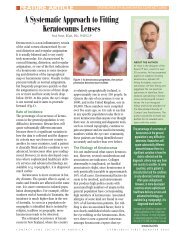PDF file - David Thomas Contact Lenses
PDF file - David Thomas Contact Lenses
PDF file - David Thomas Contact Lenses
- No tags were found...
You also want an ePaper? Increase the reach of your titles
YUMPU automatically turns print PDFs into web optimized ePapers that Google loves.
Rose K2 IC Design Information<br />
The Rose K IC lens design is manufactured with a larger posterior optical zone than standard<br />
lenses. It has an aspheric posterior surface incorporating aberration controlled optics and reverse<br />
geometry para-cental fitting curves. The Rose K2 IC lens has a standard diameter of 11.4mm and<br />
can be supplied up to 12.0mm diameter.<br />
Rose K2 IC Availability<br />
It is recommended that the Rose K2 IC lens design be fitted from a diagnostic trial lens set only. This<br />
is supplied as a twenty lens diagnostic trial set in Boston ES non-uv material to aid accurate<br />
fluorescein assessment. The diagnostic trial set is supplied in an 11.4mm diameter and standard edge<br />
lift with a base curve range from 6.0mm to 6.8mm in 0.2mm steps, 6.9mm to 8.0mm in 0.1mm steps<br />
and 8.0mm, 8.4mm and 8.6mm.<br />
Rose K2 IC Parameter Range<br />
Base Curve: 5.7mm to 9.0mm in 0.1mm steps<br />
Diameter: 9.4mm to 12.0mm in 0.1mm steps<br />
Power: +30.0D to -30.0D in 0.25 steps<br />
Edge Lift: Standard, Increased, Double Increased, Decreased and Double Decreased.<br />
Rose K2 IC Material<br />
It is important that with all large diameter lenses oxygen permeability is not compromised and the<br />
Rose KIC lens is available in Boston XO blue,green or violet tints and Menicon Z blue tint.<br />
irregular cornea<br />
<strong>David</strong> <strong>Thomas</strong> <strong>Contact</strong> <strong>Lenses</strong> Ltd<br />
Gatelodge Close<br />
Round Spinney<br />
Northampton NN3 8RJ<br />
Tel: +44 (0)1604 646216<br />
Fax: +44 (0)1604 790366<br />
Email: enquiries@davidthomas.com
<strong>David</strong> <strong>Thomas</strong> <strong>Contact</strong> <strong>Lenses</strong> now offer a solution to fitting the Irregular<br />
Cornea successfully - the Rose K2 IC lens<br />
With increased practitioner interest and the availability of modern instrument technology such as<br />
corneal topographers, the irregular cornea is no longer the difficult challenge it used to be. <strong>David</strong><br />
<strong>Thomas</strong> <strong>Contact</strong> <strong>Lenses</strong> have now helped bring the fitting of irregular cornea with specialist lenses<br />
into the hands of any contact lens practitioner. Through investment in the latest lathing and oscillating<br />
tool technology and now the introduction of the Rose K2 IC lens design, <strong>David</strong> <strong>Thomas</strong> <strong>Contact</strong><br />
<strong>Lenses</strong> can offer the practitioner a solution to fitting even the most difficult cases with a high degree<br />
of success.<br />
Rose K2 IC Indications<br />
The Rose K2 IC contact lens for irregular corneas is a large diameter GP lens which opens up an<br />
extended range of applications such as Pellucid marginal Degeneration (PMD), Keratoglobus, Post<br />
Graft, and LASIK Induced Ecstasia with secondary applications for Nipple and Oval cones.<br />
Pellucid Marginal Degeneration (PMD)<br />
PMD is a bilateral corneal disorder hallmarked by a thinning of the inferior peripheral cornea<br />
typically 1 to 2mm above the inferior limbus (figure 1). It is usually restricted to the 4-8 o’clock region.<br />
The cornea will exhibit a flat area just inside this region before steepening rapidly as the cornea thins<br />
and is characterised by large degrees of central against the rule astigmatism (figure 2). Topography<br />
maps often show a pattern ‘likened to two birds kissing’.<br />
Rose K2 IC Fitting Guidelines<br />
Initial Base Curve Selection<br />
If the patient is already wearing RGP lens then select a base curve similar to the present lens. If the<br />
patient is not wearing an RGP lens then take the K readings and select a trial lens 0.2mm steeper than<br />
the average of the two K readings. If using topography then start with a trial lens close to the<br />
measurement at the temporal 4-5mm position. This is only an initial indication as to what trial lens to<br />
first select.<br />
Central Fit<br />
Allow the lens to settle for a few minutes and ignore the peripheral fit at this stage. Evaluate the lens<br />
fit immediately after a blink when the lens is centred. A light central touch is the goal. A slightly flatter<br />
fit is more desirable then a steeper fit as the central touch is spread over a larger area and the<br />
cornea does not erode as much in normal keratoconus. With Lasik cases some central pooling over<br />
the ablation area will be present because of the significant flattening. Even with reverse geometry<br />
lenses this central pooling often has to be accepted.<br />
Peripheral Fit<br />
Once a good central fit has been achieved then assess the peripheral fit. The ideal fluorescein band<br />
width at the edge of lens will be 0.5mm to 0.7mm. This may not be uniform around the whole<br />
diameter of the lens, but it should not display excessive lift off or excessive sealing in any one area.<br />
By ordering increased or decreased edge lift the optimal fluorescein band width can be achieved.<br />
For asymmetric edge lift differences a toric periphery can be ordered. For significant edge lift stand<br />
off usually inferiorly, an ACT (Asymmetric Cornea Technology) lens can be ordered.<br />
Figure 1 - Pellucid Marginal Degeneration<br />
(Courtesy of Pat Caroline)<br />
Figure 2 - PMD with high ATR astigmatism<br />
(Courtesy of Pat Caroline)<br />
Diameter<br />
The standard diameter is 11.4mm. Selecting the correct diameter will help lens location. Increasing the<br />
overall diameter will nearly always help improve lens location, however, ensure that the lens is not<br />
too large to impinge on the upper sclera.<br />
Keratoglobus<br />
In instances of globus cones where a large area of the cornea is affected of which up to 75% is<br />
below the visual axis, then Munson's sign is usually present. This is where there is forward<br />
displacement of the lower lid by the cone on downward gaze.<br />
Post Graft<br />
Where patients have undergone penetrating keratoplasty or a corneal graft, then the Rose K IC lens<br />
is useful to aid postoperative recovery and improve vision. In these cases a large diameter lens is<br />
preferable to bridge the graft and host/donor junction. Expect to see significant toricity in most<br />
grafts.<br />
Power Evaluation<br />
Perform over refraction in a well illuminated room. Over refract using ±1.00D steps initially and then<br />
refine with 0.50D and 0.25D steps. Include evaluation of residual astigmatism.<br />
Fitting Pearl<br />
Lens location is the biggest issue with the irregular cornea. Poor, usually inferior location can be<br />
remedied by using a combination of diameter and edge lift changes. These are your greatest tools<br />
in solving this common problem.<br />
LASIK induced ecstasia<br />
Lasik procedure can occasionally lead to complications such as Lasik Induced Ecstasia. This causes an<br />
outward bulging of the cornea resulting in irregular astigmatism and poor vision and usually<br />
happens when the cornea is not thick enough to leave an adequate stromal bed following Lasik<br />
treatment.
















